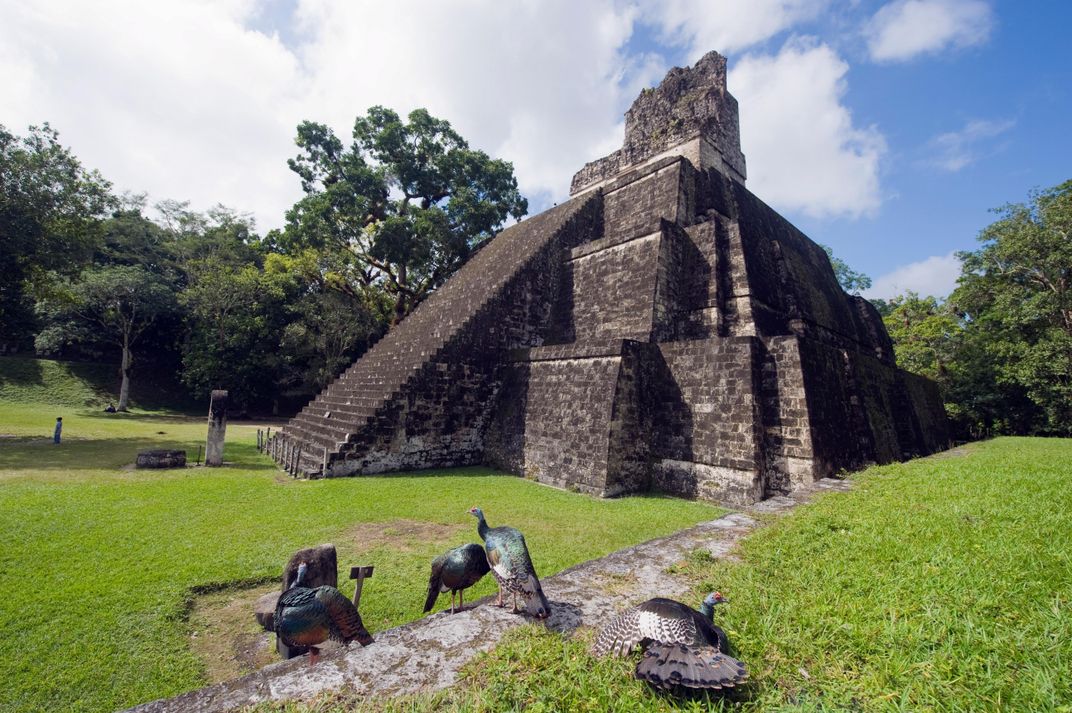Your Thanksgiving Turkey Is a Quintessentially American Bird: An Immigrant
The turkeys common on U.S. tables descended from a Mexican species and were originally bred for Maya rituals
/https://tf-cmsv2-smithsonianmag-media.s3.amazonaws.com/filer/65/a5/65a5c245-ce2e-4fd5-805d-34e8fbf8a116/lw003311.jpg)
This week Thanksgiving tables across the nation will be laden with that most American of birds, the turkey. But while certain turkeys are native to this country, the holiday bird commonly eaten today is typically American in a way many people don't suspect—it's descended from immigrants.
“These are essentially Mexican birds, arrived in the U.S. by way of Europe,” explains archaeologist Erin Thornton, who studies turkey husbandry among the ancient Maya.
Genetic studies show that M. gallopavo gallopavo, the South Mexican wild turkey, is the ancestor of all today's domestic turkeys. Bones from these birds were present as early as 300 B.C. at the Maya city of El Mirador in Petén, Guatemala, which is a site outside their natural range. This suggests that they were being traded by humans and raised in captivity.
Another study of bones, fossilized excrement and DNA from dozens of archaeological sites concludes that a different turkey lineage was domesticated separately in the American Southwest at approximately the same time. But those early domesticated turkeys weren't raised for their succulent taste.
“It does look like the very earliest domesticated turkeys in the Southwest were probably not for eating but used more for ritual purposes, for feather blankets, for prayer stick feathers perhaps, and even ritual interment,” says archaeologist Camilla Speller of the University of York.
The story appears to be similar among the Maya, Thornton says. “Even though the Maya were increasing at that time, they didn't suddenly adopt turkeys as a solution to feeding their growing populations. Instead, it looks like there were very small numbers trickling in, and that they were limited to the elite. So they probably were these kind of interesting or ritually symbolic animals that were controlled by the rulers of society for ceremonies or feasting.”
By the time the Spanish arrived in the New World in the 15th century, the birds were in wide domestic use and were being consumed in large quantities by humans and beasts alike.
“The Spanish encountered them very early on when they came to the Americas,” Speller explains. “Historic accounts describe Montezuma's menagerie, which contained hundreds of raptors that were fed on turkeys. Turkeys would have been very prevalent at the time of contact, in marketplaces and on village farms.”

The Spanish liked what they saw and presumably enjoyed what they tasted—Speller says the first turkeys were shipped to Europe sometime around the year 1500, and their Old World arrival was a smashing success.
“Certainly turkeys spread very rapidly,” she says. “In about a hundred years we can see them spread throughout Europe." Many European barnyards already featured a bird called a turkey, a smaller species noted as far back as Aristotle that was also called the guinea fowl, because they were sourced from that part of Africa. With the arrival of New World turkeys, the guinea fowl name became standard for these birds, and European farmers began welcoming the larger version.
"Turkeys were seen as exotic, a kind of status symbol in your backyard, particularly the males," says Speller.
That means by the time of Plymoth's 1621 Thanksgiving feast, turkeys had been familiar to Europeans for more than a century. And in a strange twist of global commerce, human immigrants headed to the Americas brought the originally Mexican birds with them back across the Atlantic.
“Settlers attempted to re-create their European lifestyle in the Americas and transported all their domestic animals, including turkeys,” says Speller. “The commercially raised birds that we eat today are ultimately descended from those turkeys that were imported back from Europe to the Eastern Seaboard during the 17th and 18th centuries.”
In the melting pot of America, the turkeys that arrived with European settlers were subsequently mixed with some of the Eastern wild turkey populations to produce a more appetizing product. But breeding birds for the dinner table has come with a cost: a loss of genetic diversity.
A 2012 DNA study found that the turkey genome is much less diverse than that of other livestock animals like chickens or pigs. The study compared genes from seven commercial breeds, three heritage varieties and some South Mexico wild turkeys found in the collection of the Smithsonian's National Museum of Natural History, gathered in Chihuahua, Mexico back in 1899.
Selecting for commercially desirable traits like body size and breast development has reduced the variation that was once present in the wild Mexican ancestors of today's commercial birds, the study concludes. While those changes make turkeys more appealing to Thanksgiving feasters, it may also make them more susceptible to health problems.
“We know from things like the recent occurrence of a highly pathogenic avian flu outbreak in the Midwest, or even going back to the potato famine in Ireland, that putting all of your genetic hope into a few really strong robust lines is kind of risky,” says study co-author Julie Long of USDA's Agricultural Research Service.
“We need to make sure that we maintain the other genetics that are out there in wild populations and in heritage turkeys. They may not be good for commercial production right now, but we can't predict what will happen in the future, so we need to hang on to every bit of genetic diversity that we've got.”
Long helps to do just that by cryopreserving turkey sperm and the eggs of rare turkey lineages. Nobody knows which of them might hold a trait that proves important for commercial lineages facing an uncertain future. Unfortunately, the original ancestor of the Thanksgiving turkey won't be much help: While millions of wild turkeys roam American woods today, both of the lineages that were originally domesticated in the New World are now thought to be extinct.